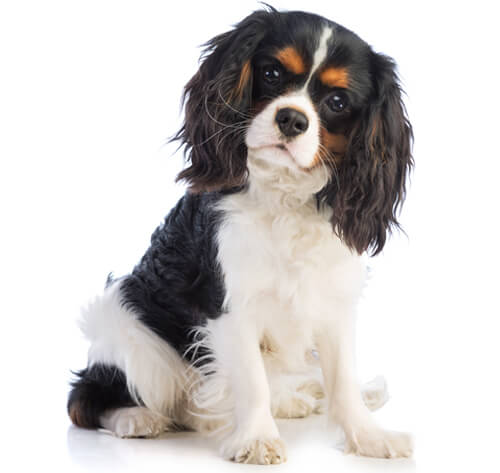
A small spaniel with a short, but definite muzzle, large brown eyes and silky fur, the Cavalier dog's colours are black and tan, ruby, red and white (Blenheim) and tricolour (chestnut markings on a pearl white background). Adults measure 30-33cm and weigh 5.5-8kg.
The need-to-know
- Dog suitable for experienced owners
- Basic training required
- Enjoys gentle walks
- Enjoys walking an hour a day
- Small dog
- Minimum drool
- Requires grooming every other day
- Non hypoallergenic breed
- Chatty and vocal dog
- Guard dog. Barks and alerts
- Great with other pets
- Great family dog
Personality

This is an affectionate, undemanding family dog that is friendly with everyone, so he makes a good companion for sensible children and the more active elderly. They are not excessive barkers but will announce strangers. They are no guard dogs however, as they greet most people warmly. Cavalier King Charles Spaniels get along with everyone, including cats and other small pets. Being relatively small and easygoing, they make good travel companions.
History and Origins

The original Cavalier King Charles Spaniel dog breed was developed from the toy spaniels pictured in the work of 16th, 17th and 18th century painters such as Titian and Gainsborough. They were very common as a ladies' pet and were used to warm laps. King Charles II was so fond of his spaniels he could not be parted from them. By 1800, the snub-nose variety had taken over in popularity and the original spaniel was nearly lost. Only the Duke of Marlborough kept a line alive, breeding them at Blenheim castle. In 1926, an American, Roswell Eldridge, tried to re-establish the original dog of the Cavalier King Charles Spaniels by offering a prize for a dog with the appearance of the dogs in the historical portraiture. The prize was given out at Crufts for the then substantial sum of £25.
Nutrition and Feeding

Small dogs have a fast metabolism, meaning they burn energy at a high rate, although their small stomachs mean that they must eat little and often. Small-breed foods are specifically designed with appropriate levels of key nutrients and smaller kibble sizes to suit smaller mouths. This also encourages chewing and improves digestion.
Exercise

A King Charles Spaniel will adapt to whatever amount of exercise you feel able to give but do need some regular exercise or they will put on the pounds. About an hour's daily exercise is a good guide but they also enjoy games and training in which they can excel.
Other Information

Health and common issues
The most common inherited problems affecting the Cavalier King Charles Spaniel are heart disease, and a brain/spinal disorder (syringomyelia). As with many breeds, they can also suffer from various hereditary eye disorders, and hip dysplasia (a condition that can lead to mobility problems). Eye testing, hip scoring, brain/spine and heart assessment of dogs prior to breeding is therefore very important.
Best family dog breeds
While many dogs are traditionally thought of as being good with children , all dogs and children need to be taught to get on with and respect each other, and be safe together. Even so, dogs and young children should never be left alone together and adults should supervise all interactions between them.